“When Jesus therefore was born in Bethlehem of Juda, in the days of king Herod, behold, there came wise men from the east to Jerusalem. Saying, Where is he that is born king of the Jews? For we have seen his star in the east, and are come to adore him…And entering into the house, they found the child with Mary his mother, and falling down they adored him; and opening their treasures, they offered him gifts; gold, frankincense, and myrrh.” —Matt. 2:1-2, 11
“And it came to pass, in those days, Jesus came from Nazareth of Galilee, and was baptized by John in the Jordan. And forthwith coming up out of the water, he saw the heavens opened, and the Spirit as a dove descending, and remaining on him. And there came a voice from heaven: Thou art my beloved Son; in thee I am well pleased.” —Mark 1:9-11
Today is the feast of Epiphany and Theophany, also known as “Twelfth Night.” It is a feast to commemorate two major revelations of the God-man Jesus Christ to the world.
Firstly, what does it mean that today we mark Twelfth Night? The Twelve Days of Christmas aren’t just a song—there are traditionally twelve days after Dec. 25 also celebrated as Christmas, ending on Jan. 6. Catholics still celebrate the Epiphany, but even among Protestants in some areas, particularly 18th-century America, “Twelfth Night” used sometimes to be a bigger celebration than Christmas Day. There are various wonderful ways to celebrate the feast, including the king cakes and other traditions I have previously described, but what exactly is the feast about? Epiphany commemorates the coming of the three kings or Magi to adore the Christ Child (Matt. 2), and Theophany commemorates Jesus’s baptism in the Jordan River (Matt. 3, Mark 1) and the revelation of the Trinity that followed it. Both feasts are celebrated today.
There is obvious importance to these two Biblical feasts, celebrated simultaneously (along with a remembrance of Jesus’s first miracle at Cana, in John 2), with the Epiphany more emphasized in the West and the Theophany more emphasized in the East. Epiphany represents the first time it was clear that the Messiah came not only for God’s chosen people, the Jews, but for the whole world (the “Gentiles”). Jesus came to save the pagans from the demon-worship and nature-worship that had kept them in spiritual darkness so long. The three gifts of the Magi are also significant in revealing Jesus’s various roles, as the Divine Priest (frankincense, which was and is used in religious liturgies), as the sacrifice for the sins of the world (myrrh, used to embalm dead bodies), and as the King of the Universe and heir to Jewish King David (gold).
Meanwhile, Theophany shows the vital importance of baptism; connects the Old and New Testaments since St. John the Baptist is the last prophet of the Old Law; and reveals the mystery of the Triune God, one God in three persons. Even the Jews, God’s beloved Chosen People, did not previously know the mystery of the Trinity.
There are many works of art that have magnificently depicted both Theophany and Epiphany, as you can see above, but I always like to focus on one in particular. While the Gospel doesn’t say how many kings there were, a mid-6th-century mosaic said by scholars to be one of the earliest artistic depictions of the Magi shows three kings—and even includes their names.
One of the earliest depictions of the Three Magi is said to be a mosaic in Sant’Apollinare Nuovo, a 6th-century basilica church in Ravenna, Italy, which was built when the Roman empire was based in Constantinople. Ravenna was, at the time the mosaic was made, perhaps the most significant city politically in Italy, at least from a Byzantine point of view, because Ravenna was where the Western representative (or exarch) of the Roman emperor lived. The basilica of Sant’Apollinare Nuovo was originally built c. 506 A.D. by Ostrogoths; interestingly, the Ostrogoths were Arian heretics (meaning they believed the Son of God was created and thus not fully divine). The basilica was later significantly redone, however, after the Catholic Byzantine/Roman emperor Justinian was in control of Ravenna, and it was during this mid-6th-century period of Byzantine control and redecoration that the stunning mosaic of the Magi was created. The mosaic seems to be the source for the names usually associated with the kings (being the first recorded mention of them), though there was almost certainly some sort of tradition behind the names: Gaspar (or Caspar), Melchior, and Balthassar. They are considered saints by the Catholic Church.
Notice that one king is youthful and beardless, one king is bearded in the prime of his life, and one king is an old man with hair and beard of white. The Magi were traditionally depicted as representing the three main stages of man’s life: youth, prime or middle age, and old age.
While the image above is a close-up on the Magi, the kings are actually part of a larger mosaic, heading up a procession of virgins:
The Magi are processing towards the Blessed Virgin Mary and the Child Jesus, enthroned and flanked by angels:
Here is a view of the entire scene on the basilica wall:
The mosaic of the Magi in Sant’Apollinare Nuovo is not only a testament to the artistic skill of those who made the mosaic but also a beautiful illustration of the story that so perfectly represents how Jesus turned the proud conventions of the world upside down: the story of the learned pagan kings who traveled long distances just to pay homage to a poor Jewish baby who was really the Creator and King of the world.
Listen below for the beloved Christmas song about the Magi:




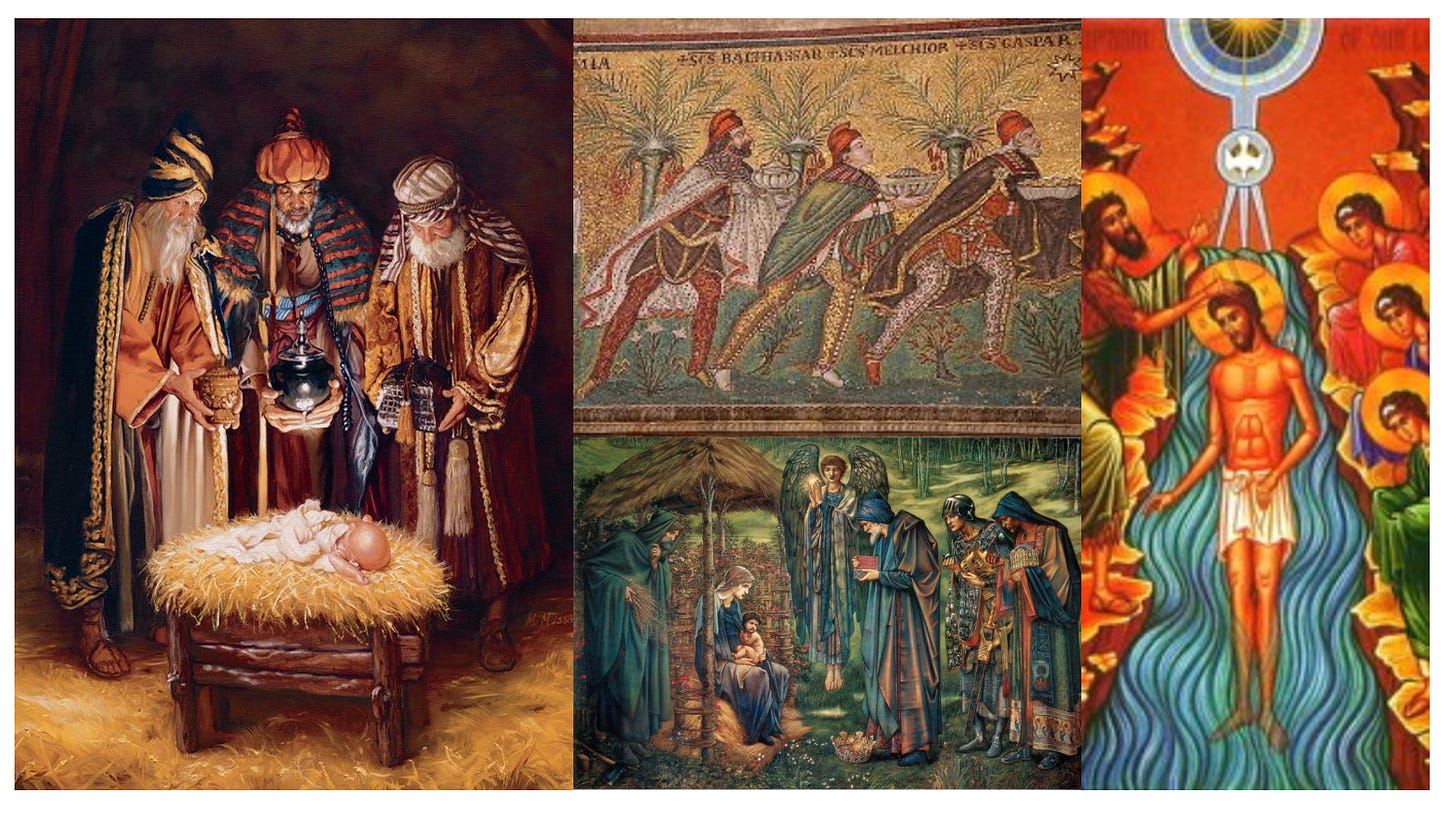
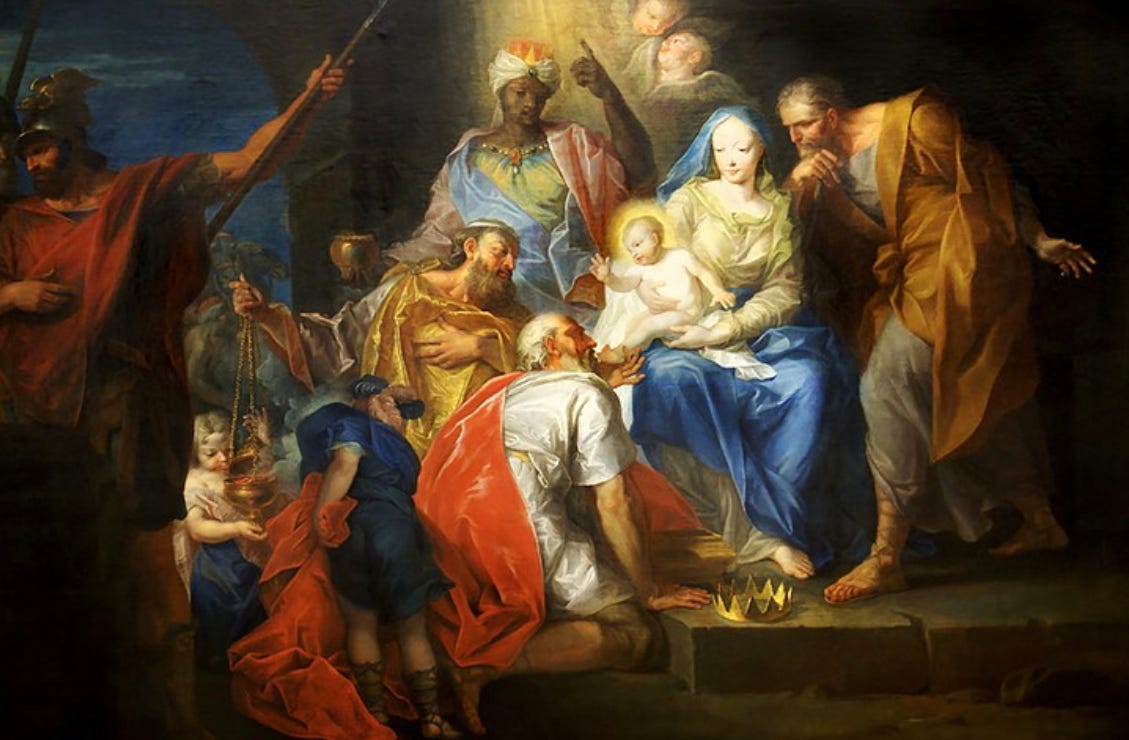
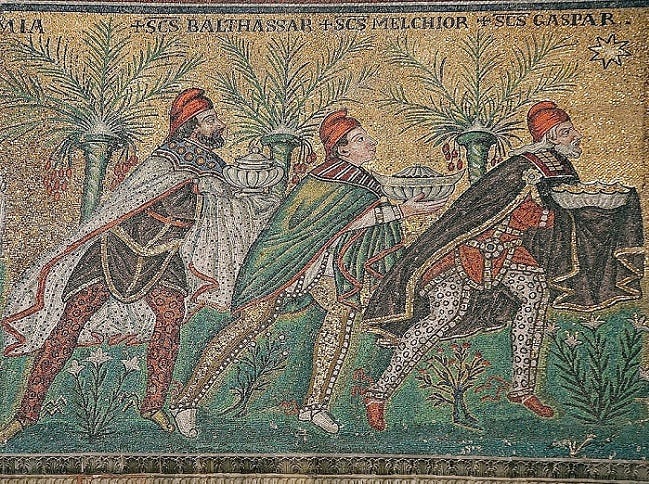
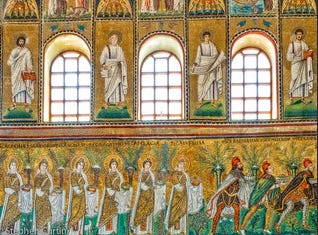
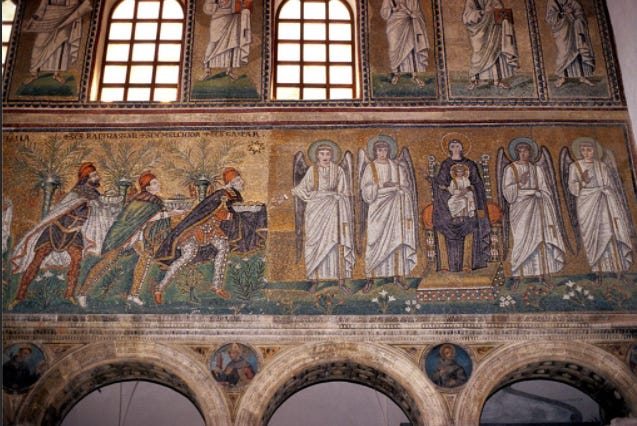
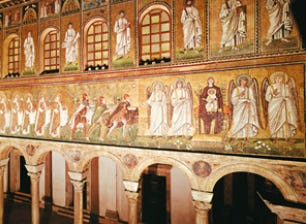
Interesting observations of the 3, they used the science of the day and intellect critical thinking to navigate between snake oil and the real deal. But that only got them as far as Bethlehem. Which size wise would have fit inside the Temple grounds. There, they had to ask for Directions, humility, docility to learn, to Navigate from the visible Star, to the feeding trough manger where lay the Bread of Life and Light of the World. But even guided by Grace, they still were Weiseinheimers, and messed up telling Herod there is a new King in town to replace you. In their exuberance and hubris, not forwards grasping the ramifications of their actions. Even the 3 Wise Men, Kings Solomon and David needed forgiveness and Graces.